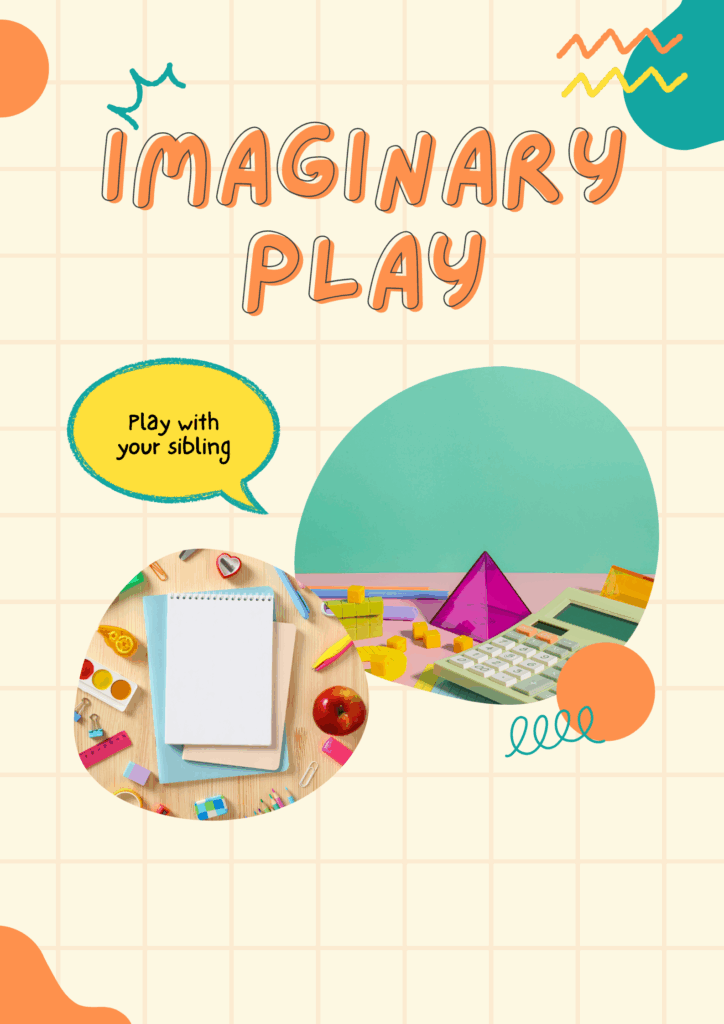13 Joyful Ways Imaginary Play Great To Strengthen Sibling Bonds at Home

Imaginary play is like the secret language of childhood: half magic, half chaos, and always unpredictable. If you’ve ever heard your kids yelling, “You be the dragon, and I’ll be the pizza delivery driver!” you know exactly what I mean. It’s messy, it’s loud, and it’s absolutely wonderful.
But here’s the best part: imaginary play doesn’t just keep kids entertained. It builds something deeper; it helps siblings form strong bonds at home. Instead of fighting over toys or the last cookie, they’re working together to create worlds, solve problems, and share laughter.
In this blog, we’ll explore 13 joyful ways imaginary play strengthens sibling bonds, with plenty of real-life examples and easy guides so you can encourage more magical moments right in your living room.
1. Building Kingdoms Together
One of the simplest joys of imaginary play is letting siblings create their own kingdoms. With blankets for castles, chairs for thrones, and stuffed animals as loyal subjects, kids can work together to design a world.
- Bonding element: Cooperation in assigning roles (king, queen, knight, or wizard).
- Guide: Give them open-ended props and let them decide the story. The teamwork of setting rules and respecting each other’s “kingdom laws” strengthens trust.
2. Adventure Quests in the Living Room
Turn the couch into a mountain, the rug into lava, and the hallway into a cave. Suddenly, siblings are brave explorers on a quest to save their imaginary land.
- Bonding element: They learn problem-solving and negotiation (“You distract the monster, and I’ll grab the treasure”).
- Guide: Provide simple “quest items” like a toy sword or flashlight, but let them lead the storyline.
3. Running a Pretend Restaurant
Few things bring siblings together like “cooking.” With pots, pans, and maybe a few safe kitchen items, they can open their own restaurant.
- Bonding element: Collaboration in menu design, taking turns as chef and waiter.
- Guide: Offer them paper to write menus. Watch as they giggle over serving “chocolate spaghetti” or “broccoli ice cream.”
4. Imaginary Play Doctors and Patients
One child becomes the doctor, the other the patient, and suddenly laughter fills the room. They invent illnesses like “giggle fever” or “jumping bean syndrome.”
- Bonding element: They practice empathy by caring for each other.
- Guide: Add bandages, a toy stethoscope, or even a stuffed bear patient for extra fun.
5. Building Worlds with Jumbo Blocks
When siblings dive into construction play, especially with jumbo blocks, their collaboration skyrockets. Towers, castles, even imaginary cities come to life as they plan and build together.
- Bonding element: Shared creativity, patience, and celebrating achievements together.
- Guide: Step back and let them argue a little over “which block goes where.” It teaches compromise and shared problem-solving.
6. Space Explorers on a Mission
Turn a cardboard box into a rocket ship, and suddenly siblings are blasting off to Mars. They can invent alien encounters, navigate asteroid fields, and name their planets.
- Bonding element: They must coordinate roles (captain, engineer, alien translator).
- Guide: Add foil hats or glow sticks to make the adventure extra special.
7. Putting on a Family Talent Show
Imaginary play shines when siblings join forces to entertain. A talent show lets them sing, dance, or act out hilarious skits.
- Bonding element: They encourage and support each other instead of competing.
- Guide: Record their show so they can watch it later and laugh together.
8. Running a Pretend Shop
With toys, books, or even cereal boxes, siblings can set up a pretend shop. One sells, the other buys, and the game can last for hours.
- Bonding element: Practicing sharing, counting, and role reversal (switching buyer/seller).
- Guide: Give them fake money or coins for a more realistic experience.
9. Superhero Sibling Duo
When kids don capes (even if it’s just a towel), they transform into heroes. Together, they can save stuffed animals from “villains” or rescue a doll trapped in a basket.
- Bonding element: Teamwork against a common imaginary enemy.
- Guide: Encourage them to invent superhero names and powers that complement each other.
10. Storytime Theater
Imaginary play can be as simple as acting out their favorite books. One child narrates, while the other performs, and then they swap.
- Bonding element: Listening to each other and taking turns.
- Guide: Give them props (hats, scarves, or masks) to bring the story alive.
11. Pretend Travel Adventures
Suitcases, backpacks, and a map can transport siblings to anywhere in the world. They can pretend to visit Paris, the jungle, or even the North Pole.
- Bonding element: Shared imagination in choosing destinations and “travel experiences.”
- Guide: Let them stamp “passports” you print out at home.
12. Mystery Solvers
Imaginary play as detectives gives siblings the thrill of solving mysteries together. Whether it’s finding a missing toy or discovering who “ate the cookies,” teamwork takes center stage.
- Bonding element: Problem-solving and critical thinking.
- Guide: Hide small objects around the house and give them “clues.”
13. Family Band Fun
Spoons become drums, boxes become guitars, and suddenly you’ve got a sibling rock band.
- Bonding element: Collaboration through rhythm, sound, and silly lyrics.
- Guide: Record their songs and play them back it builds pride and togetherness.
Why Imaginary Play Matters for Sibling Bonds

Throughout all these activities, imaginary play does more than just fill time. It:
- Encourages teamwork over rivalry
- Builds empathy and listening skills
- Sparks laughter and positive memories
- Creates traditions siblings will carry into adulthood
Instead of constant competition, kids learn to be partners in creativity. And those bonds, formed through games and shared adventures, often last a lifetime.
Friendly Tips for Parents
If you want to make imaginary play a regular part of your home life:
- Provide open-ended props (blankets, boxes, scarves, blocks).
- Step back—let kids argue a little, then figure it out together.
- Join occasionally as a “guest star,” but let them lead the play.
- Celebrate their creativity by taking photos or videos.
Final Thoughts
Imaginary play isn’t just child’s play, it’s relationship building in disguise. When siblings collaborate on quests, build worlds, or solve mysteries together, they’re weaving bonds that strengthen family life.
So the next time you hear your kids arguing about who gets to be the dragon, smile. Because in that chaos, they’re also learning patience, creativity, and how to love each other better.
And trust me someday, they’ll look back and laugh at the magical worlds they created side by side.
